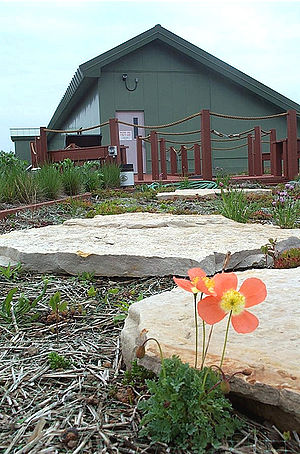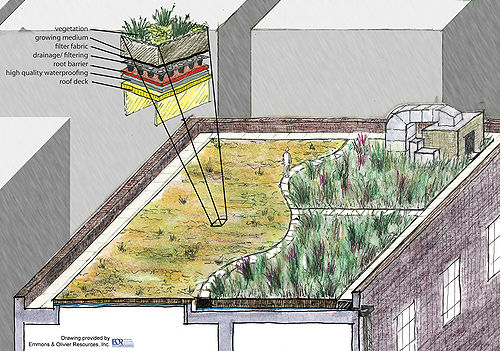
Difference between revisions of "Green roofs"
m (→Description) |
m |
||
| Line 1: | Line 1: | ||
{{alert|The information on green roofs will be updated in early summer of 2013|alert-under-construction}} | {{alert|The information on green roofs will be updated in early summer of 2013|alert-under-construction}} | ||
| + | {{alert|The anticipated review period for this page is June through September 2013|alert-under-review}} | ||
*[[Overview for green roofs]] | *[[Overview for green roofs]] | ||
Revision as of 15:41, 2 July 2013
The information on green roofs will be updated in early summer of 2013
The anticipated review period for this page is June through September 2013
- Overview for green roofs
- Types of green roofs
- Design criteria for green roofs
- Construction specifications for green roofs
- Construction observations for green roofs
- Assessing the performance of green roofs
- Operation and maintenance of green roofs
- Calculating credits for green roofs
- Cost-benefit considerations for green roofs
- Plant lists for green roofs
- Additional considerations for green roofs
- Links for green roofs
- References for green roofs
- Supporting material for green roofs
- Green roofs terminology and glossary
Green roofs consist of a series of layers that create an environment suitable for plant growth without damaging the underlying roof system. Green roofs create green space for public benefit, energy efficiency, and stormwater retention/ detention.
Contents
Design criteria
Structural load capacity, how much weight the roof can hold, is a major factor in determining whether the green roof is “extensive” or “intensive”. Vegetation selection is based on numerous factors including, growth medium depth, microclimate, irrigation availability and maintenance. A leak detection system is recommended to quickly detect and locate leaks.
Benefits
- Reduce, delay, and cool stormwater runoff
- Can significantly lower building energy costs
- Provide habitat for birds and insects
- Increase longevity of traditional roofing systems by protecting from ultraviolet rays
- Reduce carbon dioxide levels and heat island effect
- Local food production
- Decreased stormwater utility fee
- Aesthetics
- Create gardens even where open space is not available at grade
- Can be used for stormwater treatment in many areas where other LID techniques might not work (e.g. redevelopment projects with limited open space, areas with high bedrock, karst topography, contamination)
- Beneficial in hospitals (see Ulrich, 2002)
Limitations
- Initial capital cost is higher (Note: considering lifecycle costs may make green roof a more attractive investment due to increased roof lifespan, increased energy efficiency, and stormwater benefits).
- Leaks can cause significant damage and can be hard to locate and repair without an electronic leak detection system. ANSI/SPRI RP-14 Wind Design Standard for Vegetated Roofing Systems, available at http://www.spri.org, gives guidelines on how to design to minimize wind damage in green roofs, including, for example, how to evaluate what roofs are too windy for a green roof, and where a green roof may need extra wind protection.
- Conditions can be harsh for vegetation establishment.
- Maintenance needs can be higher than traditional roofing system.
- Building codes and insurance
Management suitability
- Water Quality (Vwq) - High
- Channel Protection (Vcp) - Med.
- Overbank Flood Protection (Vp10) - Low
- Extreme Flood Protection (Vp100) - Low
- Recharge Volume (Vre) - Low
See Unified sizing criteria for explanation of these terms.
Mechanisms
- Screening/ Filtration
- Temperature Control
- Evaporation
- Transpiration (if vegetated)
- Soil Adsorption
- Biological/ Micro. Uptake
Pollution removal
- Total Suspended Solids - 90%
- Nutrients - Total Phosphorus/Total Nitrogen - 100%/ 20%
- Metals - Cadmium, Copper, Lead, and Zinc - 80%
- Pathogens - Coliform, Streptococci, E. Coli - 65%
NA Toxins - Hydrocarbons, Pesticides
Site factors
- Drainage Area - Rooftop
- Max. Slope - NA.
- Min. Depth to Bedrock - NA.
- Min. Depth to Water Table - NA.
- SCS Soil Type (can be used in C&D soil types with modifications (e.g. underdrains)) - NA
- Freeze/ Thaw Suitability - Good
- Potential Hotspot Runoff (requires impermeable liner) - Suitable
Note: Pollution removal percentages apply to volume of runoff treated, and not to volume by-passed
Description
There are two systems of green roofs, extensive and intensive, composed of the same system of layers. Extensive systems are lighter, typically have 6 inches or less of growing medium, use drought tolerant vegetation, and can structurally support limited uses (such as maintenance personnel). Intensive systems are heavier, have a greater soil depth, can support a wider range of plants, and can support increased pedestrian traffic.
Rainfall is initially intercepted by vegetation, held on foliage, or soaked up by plant roots. Any remaining runoff filters through the growing medium and is drained away from the roof’s surface by the drainage layer. This water can be captured in cisterns to irrigate plants or for other re-use purposes. Some drainage systems use small depressions to store excess water for uptake during drier conditions (RCWD), while others provide an overflow for larger rainfall events.

